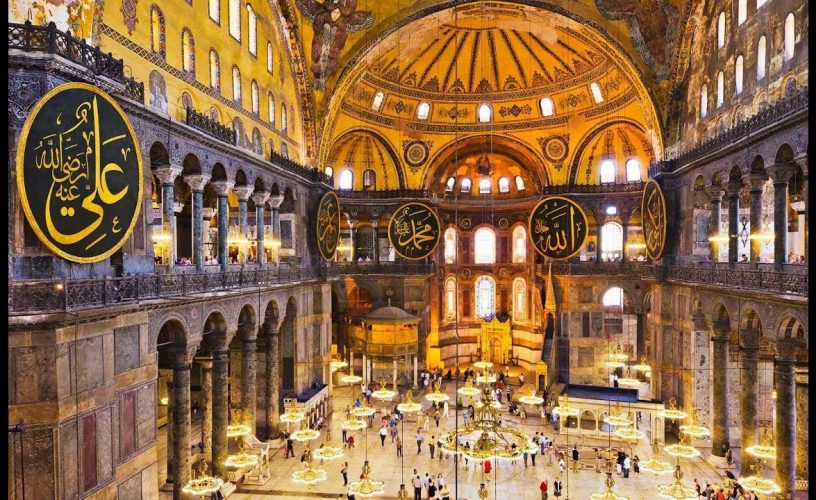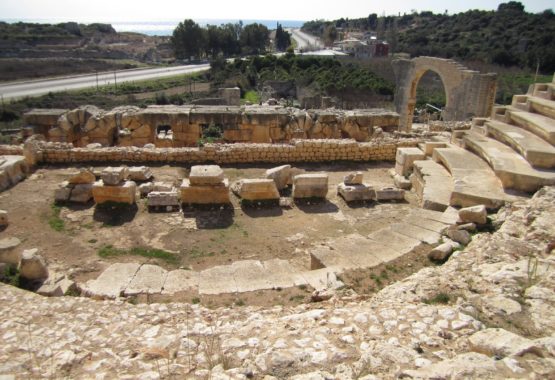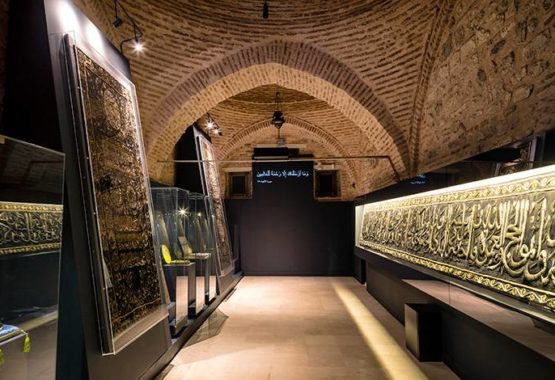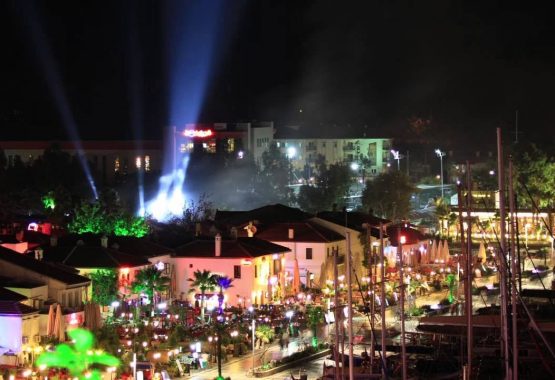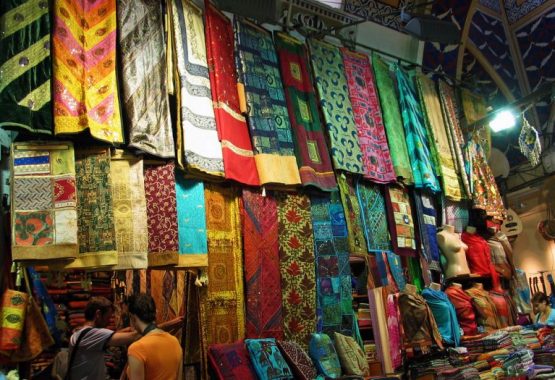Hagia Sophia means “Divine Wisdom” in Greek, this was an Orthodox church dedicated to holly wisdom, not to a Saint Sophia as some people wrongly call it today.
Hagia Sophia is the one of the most visited museums and most prominent monuments in the world in terms of art and the history of architecture. It has also been called “the eighth wonder of the world” by East Roman Philon as far back as the 6th century. The current Hagia Sophia is the third construction, done in a different architectural style, even though it occupies the same location as the previous two. The original building was constructed by the most important architects of the period (527-565), Anthemios (Tralles) and Isidoros (Miletus), under the order of Emperor Justinianos. It is mentioned in the resources that during its construction period, the two prominent architects each had 100 architects working under them, who in turn had 100 workers each working under them.
It was used as a church for 916 years but, following the conquest of Istanbul by Fatih Sultan Mehmed, the Hagia Sophia was converted into mosque. Afterwards, it was used as a mosque for 482 years. Under the order of Atatürk and the decision of the Council of Ministers, Hagia Sophia was converted into a museum in 1935.
The dome of the Hagia Sophia Turkey is 180 feet high and 100 feet wide and was considered a revolution in the history of architecture. Today, the massive dome is surrounded by four minarets which were built during the Ottoman period.
Most of the Christian mosaics of the temple are located in the upper gallery of the temple which was once the women section during both the Byzantine and Ottoman eras. The oldest mosaic dates back to the 9th century AD..
The architect Sinan was so vexed by the impressive dimensions and architecture of the Hagia Sophia, that he spent his life trying to better it. He finally reach this with his masterpiece, the Selimiye Mosque in Edirne whose dome is said to be just inches bigger.
The interior walls of the church were decorated with gold mosaics, the floors with white marble, and column capitals with the monograms of Justinian and Theodora. Marbles and columns taken from the remains of earlier civilizations from all parts of the Empire were used as building material, these pieces came from Baalbek, from Pergamon, and from the Temple of Artemis as well.
The upper galleries were used by important people or for church councils during the Byzantine period, and lower part was used by common people. When the Hagia Sophia was a mosque, the galleries were reserved for the women during prayers, and lower floor was used by the men.
In 1204 the church was rob by the Fourth Crusade, many precious relics were removed from the church and taken away. This act definitively divided the Greek Orthodox and Roman Catholic churches. Some of these relics can be seen today in the treasury of St. Mark’s Basilica in Venice, Italy. Enrico Dandolo, the Doge of Venice who commanded Latin forces during the invasion of the city, is buried inside the church on the upper gallery.
On May 29th, 1453, the Ottomans conquered Constantinople and sultan Mehmet II ordered to convert the church into a mosque. Because he admired the art, the sultan didn’t want these great mosaics to be destroyed so he plastered them over and the Ottomans made their own floral designs or geometrical patterns, as well as Coranic calligraphy on top of the plaster. In order to use it as a mosque, Mihrab and Minbar were added inside, a fountain for the ablution was placed in the courtyard, and minarets were built in different periods in the outer corners of the building. A Koranic school, soup kitchen, library, madrasa, the clock-winding house, and sultan’s mausoleums (belonging to Selim II, Murat III, Mehmet III, Mustafa I and Ibrahim) are amongst the structures added by the Ottomans. Also, large buttresses were built by Turkish architect Sinan in the 16th century to support the walls holding up the dome and to save the building from the earthquakes. The sultan’s loge was added in the 19th century during the restoration of the mosque by the Swiss origin Fossati brothers.
Hagia Sophia remained a mosque for almost 500 years until 1935 when Atatürk converted it into a museum so everybody could come to visit this architectural masterpiece and admire both Christian and Muslim art. Prayer rugs were removed from the marble floor and experts came from all around the world to remove some of the plaster in order to uncover spectacular Byzantine mosaics. It was, and still is, an important task during the restorations bringing to light all the major Byzantine mosaics but also preserving the Islamic art and calligraphy to maintain a balance between both Christian and Islamic cultures.
Interior of Hagia Sophia
Today, a huge scaffolding is placed in the center of the nave for restorations of the main dome which is accept since many years. Four angel wings decorate the four pendentives which support the dome. The chandeliers for candels or oil lamps are from the Ottoman period. There are eight wooden and skin big medallions (7.5 m – 24.6 ft diameter) with Arabic inscriptions on them, these are names belonging to, beginning from the right of the apse going to the left: Allah and Muhammad (over the apse); the first four Caliphs Abu Bakr, Omar, Osman and Ali (at the four corners of the dome); and the two grandchildren of the Prophet, Hasan and Husayn (in the nave).
Many of the gold mosaics were vandalized during the Latin rule between 1204-1261, and some were destroyed during the earthquakes. But today, some nice mosaics are in the upper gallery and some on the ground level, over the main gates. These gold mosaics are usually from the 10th and 11th centuries. For example, just above the entrance gate at the narthex is a mosaic with Jesus Christ and emperor Leon VI pleading for divine mercy, with medallions of Virgin Mary and Archangel Gabriel. Another mosaic depicting the Virgin Mary and Jesus Child can be seen above the apse, which on the right has a partly damaged Archangel Gabriel’s mosaic. In the upper gallery to the south, an important mosaic depicts “Deesis” scene, known as Universal Justice, with Christ Pantrocrator flanked by the Virgin Mary and John the Baptist. To the end of the same gallery there are two more mosaics; On the right you can see Virgin Mary and Jesus Child with Emperor John Comnenus II and Empress Irene together with their son Alexis. On the left there is Jesus Christ with Empress Zoe and her third husband Emperor Constantine IX Monomachus. Another fine mosaic can be seen over the exit gate, with Virgin Mary and Jesus Child in the center, Constantine the Great on the right presenting a model of the city of Constantinople, which he founded, and Emperor Justinian I on the left presenting a model of Hagia Sophia church, which he built.
The apse has a Mihrab and Minbar added during the Ottoman period, but originally during the Byzantine period the altar, the pulpit and the ceremony objects were all plated with silver and gold and decorated with ivory and jewels, which were removed by the Crusaders in the 13th century.
There are a total of 107 columns on the ground floor and the galleries. The marble column capitals have fine deep carvings with the imperial monograms of Justinian and Theodora. In the northern corner of the church is a special column called as “sweating column” or “crying column”, made of white marble brought from the Temple of Artemis in Ephesus. A bronze belt encircles the lower part of this column and there is a hole big enough to insert a finger. There are many legends and stories about the column; because of some drops of water coming out from the hole people beleived that this column was “crying” or “sweating”, so this was a miracle.
A ramp on the northern corner gives access to the upper galleries from which you can have a magnificent view of the central nave and see the original mosaics in the southern wing.
The bronze doors at the exit to the south are partially embedded in the floor and date back to the 2nd century BC, they were brought from a pagan temple in Tarsus.

